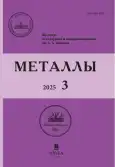Анализ процесса селективного извлечения свинца и цинка из пыли ДСП при карботермическом восстановлении
- Авторы: Подусовская Н.В.1, Комолова О.А.1, Григорович К.В.1, Демин К.Ю.1, Анисонян К.Г.1
-
Учреждения:
- ФГБУН Институт металлургии и материаловедения им. А.А. Байкова РАН
- Выпуск: № 3 (2025)
- Страницы: 14-31
- Раздел: Статьи
- Статья опубликована: 04.09.2025
- URL: https://modernonco.orscience.ru/0869-5733/article/view/688011
- DOI: https://doi.org/10.31857/S0869573325031431
- ID: 688011
Цитировать
Полный текст
Аннотация
Выполнен анализ процесса селективного карботермического восстановления оксидов свинца и цинка из пыли дуговых сталеплавильных печей (ДСП) в лабораторной горизонтальной трубчатой электропечи в среде аргона с избыточным расходом восстановителя (20 мас.%) при ступенчатом нагреве с длительностью выдержки на каждой ступени 1 ч. Установлено, что последовательные нагрев и выдержка смеси пыли ДСП и восстановителя при температурах 1100 и 1200 °С привели к удалению из пыли соответственно 96,8 и 99,9 отн.% свинца и цинка. При этом содержание железа в остатке возросло до 61,7 мас.%. Расчетом получено, что для восстановления оксидов в рассматриваемом образце пыли ДСП достаточным является введение 15,5 мас.% углерода как восстановителя. Экспериментально подтверждено, что при осаждении конденсата непосредственно на газоотводящей трубке в печи в инертной среде можно получить продукт преимущественно в металлическом виде, а охлаждение конденсата в ловушках вне печи приводит к образованию оксидов свинца и цинка, что свидетельствует об окислении материала в процессе конденсации при доступе воздуха. Данные рентгеноспектрального микроанализа конденсата, полученного в печи в инертной среде, указывают на возможность испарения из пыли ДСП не более 25 отн.% оксида свинца в газовую фазу без предварительного восстановления. В целом результаты показывают, что селективное извлечение свинца из пыли ДСП с минимальным попутным извлечением цинка должно проводиться при температуре ниже 1100 °С.
Ключевые слова
Полный текст
Об авторах
Н. В. Подусовская
ФГБУН Институт металлургии и материаловедения им. А.А. Байкова РАН
Автор, ответственный за переписку.
Email: npodusovskaya@imet.ac.ru
Россия, Москва
О. А. Комолова
ФГБУН Институт металлургии и материаловедения им. А.А. Байкова РАН
Email: npodusovskaya@imet.ac.ru
Россия, Москва
К. В. Григорович
ФГБУН Институт металлургии и материаловедения им. А.А. Байкова РАН
Email: npodusovskaya@imet.ac.ru
Россия, Москва
К. Ю. Демин
ФГБУН Институт металлургии и материаловедения им. А.А. Байкова РАН
Email: npodusovskaya@imet.ac.ru
Россия, Москва
К. Г. Анисонян
ФГБУН Институт металлургии и материаловедения им. А.А. Байкова РАН
Email: npodusovskaya@imet.ac.ru
Россия, Москва
Список литературы
- World steel in figures. 2024 [Электронный ресурс] / World Steel Association – URL: https://worldsteel.org/wp-content/uploads/World-Steel-in-Figures-2024.pdf. – (World steel in figures. 2024 [Electronic resource] / World Steel Association – URL: https://worldsteel.org/wp-content/uploads/World-Steel-in-Figures-2024.pdf.)
- Parsa Khanmohammadi Hazaveh. Purification of the leaching solution of recycling zinc from the hazardous electric arc furnace dust through an as-bearing jarosite / Parsa Khanmohammadi Hazaveh, Saeid Karimi, Fereshteh Rashchi, Saeed Sheibani // Ecotoxicology and Environmental Safety. 2020. V.202. Art.110893.
- Trifunović, V. Investigation of hazardous waste. A case study of electric arc furnace dust characterization / V. Trifunović, S. Milić, L. Avramović, R. Jonović, V. Gardić, S. Đorđievski, Silvana Dimitrijević // Investigation of hazardous waste. 2022. V.76. Is.4. P.237–249.
- Топоркова, Ю.И. Обзор методов переработки пылей электродуговой плавки / Ю.И. Топоркова, Д. Блудова, С.В. Мамяченков, О.С. Анисимова // Металлургия и материаловедение. 2021. Т.25. №5. С.643–680. – (Toporkova, Yu.I. A review of processing methods for electric arc furnace dust / Yu.I. Toporkova, D. Bludova, S.V. Mamyachenkov, O.S. Anisimova // Metallurgy and materials science. 2021. V.25. №5. P.643–680.)
- Романов, П.С. Рециклинг отходов металлургической промышленности как способ сбережения природных ресурсов и снижения экологической напряженности / П.С. Романов, И.П. Романова // Электр. научно-практический журнал «Синергия». 2016. №2. С.94–99. – (Romanov, P.S. Metals industry waste recycling as a way of preservation of natural resources and reduce environmental stress / P.S. Romanov, I.P. Romanovа // Electr. sci. pract. journal «Synergy». 2016. №2. P.94–99.)
- Kaya, M. Critical review on secondary zinc resources and their recycling technologies / M. Kaya, Sh. Hussaini, S. Kursunoglu // Hydrometallurgy. 2020. Art.105362.
- Jie Wang. Pyrometallurgical recovery of zinc and valuable metals from electric arc furnace dust – A review / Jie Wang, Yingyi Zhang, Kunkun Cui, Tao Fu, Jianjun Gao, Shahid Hussain, Tahani Saad AlGarni // Journal of Cleaner Production. 2021. Art.126788
- Подусовская, Н.В. Изучение селективного извлечения свинца и цинка из пыли ДСП при нагреве в печах сопротивления в токе аргона / Н.В. Подусовская, О.А. Комолова, К.В. Григорович, А.В. Павлов, В.В. Аксенова, Б.А. Румянцев, М.В. Железный // Известия высших учебных заведений. Черная металлургия. 2023. Т.66. №3. С.344–355. – (Podusovskaya, N.V. Lead and zinc selective extraction from EAF dust while heating in resistance furnace with flowing argon / N.V. Podusovskaya, O.A. Komolova, K.V. Grigorovich, A.V. Pavlov, V.V. Aksenova, B.A. Rumyantsev, M.V. Zheleznyi // Izvestiya. Ferrous Metallurgy. 2023. V.66. №3. P.344–355.)
- Полянский, Н.Г. Аналитическая химия элементов: Свинец / Н.Г. Полянский. – М. : Наука, 1986. 357 с. – (Polyansky, N.G. Analytical chemistry of elements: Lead / N.G. Polyansky. – Moscow : Nauka, 1986. 357 p.)
- Живописцев, В.П. Аналитическая химия элементов: Цинк / В.П. Живописцев, Е.А. Селезнева. М. : Наука, 1975. 106 с. – (Zhivopistsev, V.P. Analytical chemistry of elements: Zinc / V.P. Zhivopistsev, E.A. Selezneva. М. : Nauka, 1975. 106 p.)
- Большая Российская энциклопедия. Оксид цинка [Электронный ресурс] – URL: https://bigenc.ru/c/oksid-tsinka-88583a. – (The Great Russian Encyclopedia. Zinc oxide [Electronic resource] – URL: https://bigenc.ru/c/oksid-tsinka-88583a.)
- Большая Российская энциклопедия. Оксиды свинца [Электронный ресурс] – URL: https://bigenc.ru/c/oksidy-svintsa-fa0fdb. – (The Great Russian Encyclopedia. Lead oxides [Electronic resource] – URL: https://bigenc.ru/c/oksidy-svintsa-fa0fdb.)
- Справочник химика (в 7 томах) / Редкол.: Никольский Б.П. и др. 3-е изд., испр. – Л. : Химия, 1971. Т.2. 1168 с. – (Handbook of a chemist (in 7 volumes) / Edited by Nikolsky B.P. et al. 3rd ed., corrected. – Leningrad : Chemistry, 1971. V.2. 1168 p.)
- ГОСТ 10262–73. Цинка окись. Технические условия. – М. : Издательство стандартов, 1989. 17 с. – (GOST 10262–73. Zinc oxide. Technical specifications. – Moscow : Publishing House of Standards, 1989. 17 p.)
- Рабинович, В.А. Краткий химический справочник / В.А. Рабинович, З.Я. Хавин. – Л. : Химия, 1977. 376 с. – (Rabinovich, V.A. A brief chemical reference / V.A. Rabinovich, Z.Ya. Khavin. – Leningrad : Chemistry, 1977. 376 p.)
Дополнительные файлы



















